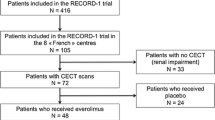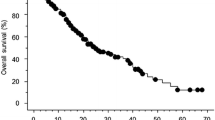Abstract
Purpose
To identify the optimum response criteria for first-line targeted pazopanib therapy in patients with mRCC using solid tumor response criteria and clinical risk factors.
Methods
Pre- and post-treatment CTs of patients (n = 43) with mRCC treated with first-line pazopanib therapy were analyzed retrospectively. Treatment response was evaluated with Response Evaluation Criteria in Solid Tumors (RECIST) v1.1, Choi, modified Choi (mChoi), revised Choi (rChoi), MASS (Morphology, Attenuation, Size, and Structure), 10% threshold criteria, and subjective assessment. Memorial Sloan-Kettering Cancer Center and International Metastatic Renal Cell Carcinoma Database Consortium clinical risk factors were also used to define response groups. Response evaluations were correlated with overall survival (OS) and progression-free survival (PFS) using log-rank test.
Results
Patients with partial response (PR) by mChoi and rChoi had longer OS than those with stable disease (SD) (P < 0.001). Responders by 10% threshold criteria also had better OS, without or combined with clinical criteria. Patients with PR by rChoi, mChoi, RECIST v1.1, MASS criteria, and by subjective assessment had longer PFS than those with SD. rChoi and mChoi criteria best delineated the difference in PFS for patients with PR versus SD, without or combined with clinical criteria.
Conclusion
For mRCC patients treated with pazopanib, OS and PFS for PR and SD groups were best predicted by rChoi and mChoi criteria, without or combined with clinical risk factors. 10% threshold criteria also predicted OS and PFS, whereas RECIST did so only in a limited number of patients.





Similar content being viewed by others
References
Eisenhauer EA, Therasse P, Bogaerts J et al (2009) New response evaluation criteria in solid tumours: revised RECIST guideline (version 1.1). European journal of cancer (Oxford, England: 1990) 45:228-247
Kang HC, Gupta S, Wei W, Lu L, Matrana MR, Tannir NM, Choi H (2017) Alternative response criteria and clinical risk factors for assessing tumor response in patients with metastatic renal cell carcinoma who are receiving salvage therapy. AJR Am J Roentgenol 209: 1278-1284
Hutson TE, Davis ID, Machiels JP et al (2010) Efficacy and safety of pazopanib in patients with metastatic renal cell carcinoma. J Clin Oncol 28:475-480
Ratain MJ, Eisen T, Stadler WM, et al (2006) Phase II placebo-controlled randomized discontinuation trial of sorafenib in patients with metastatic renal cell carcinoma. J Clin Oncol 24:2505-2512
Choi H, Charnsangavej C, Faria SC et al (2007) Correlation of computed tomography and positron emission tomography in patients with metastatic gastrointestinal stromal tumor treated at a single institution with imatinib mesylate: proposal of new computed tomography response criteria. J Clin Oncol 25:1753-1759.
Nathan PD, Vinayan A, Stott D, Juttla J, Goh V (2010) CT response assessment combining reduction in both size and arterial phase density correlates with time to progression in metastatic renal cancer patients treated with targeted therapies. Cancer Biol Ther 9:15-19
Smith AD, Shah SN, Rini BI, Lieber ML, Remer EM (2010) Morphology, Attenuation, Size, and Structure (MASS) criteria: assessing response and predicting clinical outcome in metastatic renal cell carcinoma on antiangiogenic targeted therapy. AJR Am J Roentgenol 194:1470-1478
Thiam R, Fournier LS, Trinquart L et al (2010) Optimizing the size variation threshold for the CT evaluation of response in metastatic renal cell carcinoma treated with sunitinib. Ann Oncol 21:936-941
Krajewski KM, Guo M, Van den Abbeele AD et al (2011) Comparison of four early posttherapy imaging changes (EPTIC; RECIST 1.0, tumor shrinkage, computed tomography tumor density, Choi criteria) in assessing outcome to vascular endothelial growth factor-targeted therapy in patients with advanced renal cell carcinoma. Eur Urol 59:856-862
Motzer RJ, Mazumdar M, Bacik J, Berg W, Amsterdam A, Ferrara J (1999) Survival and prognostic stratification of 670 patients with advanced renal cell carcinoma. J Clin Oncol 17:2530-2540
Motzer RJ, Bacik J, Schwartz LH, Reuter V, Russo P, Marion S, Mazumdar M (2004) Prognostic factors for survival in previously treated patients with metastatic renal cell carcinoma. J Clin Oncol 22:454-463.
Ko JJ, Xie W, Kroeger N, et al (2015) The international metastatic renal cell carcinoma database consortium model as a prognostic tool in patients with metastatic renal cell carcinoma previously treated with first-line targeted therapy: a popluation-based study. The Lancet Oncology 16:293-300
Goh V, Ganeshan B, Nathan P, Juttla JK, Vinayan A, Miles KA (2011) Assessment of response to tyrosine kinase inhibitors in metastatic renal cell cancer: CT texture as a predictive biomarker. Radiology 261:165-171
Fournier L, Bellucci A, Vano Y, et al (2017) Imaging response of antiangiogenic and immune-oncology drugs in metastatic renal cell carcinoma (mRCC): current status and future challenges. Kidney Cancer 1:107-114
Funding
Supported by the NIH/NCI under Award Number P30CA016672 and used the CCSG Biostatistics Resource Group.
Author information
Authors and Affiliations
Corresponding author
Ethics declarations
Conflict of interest
Shiva Gupta, MD; Hyunseon Christine Kang, MD PhD; Jia Sun, PhD; and Haesun Choi, MD have no disclosures. Marc R. Matrana, MD—Speaker’s Bureau: BMS, AstraZeneca, Janssen, Genentech, Eisai, Merck; Consultant: Strata Oncology, AstraZeneca. No funding was received for this study. Nizar M. Tannir, MD—Honoraria: Pfizer, Novartis, Bristol-Myers Squibb, Exelixis, Nektar; Calithera Biosciences, Eisai Medical Research, Ono Pharmaceutical; Consultant: Novartis; Exelixis, BMS, Nektar, Pfizer, Eisai, Calithera Biosciences Inc., Ono Pharmaceutical, Oncorena. Research Funding: BMS, Novartis, Exelixis, Epizyme, Mirati Therapeutics. No funding was received for this study.
Additional information
Publisher's Note
Springer Nature remains neutral with regard to jurisdictional claims in published maps and institutional affiliations.
Rights and permissions
About this article
Cite this article
Gupta, S., Kang, H.C., Sun, J. et al. Tumor response criteria for assessing pazopanib first-line therapy in patients with metastatic renal cell carcinoma (mRCC). Abdom Radiol 45, 1872–1882 (2020). https://doi.org/10.1007/s00261-019-02354-z
Published:
Issue Date:
DOI: https://doi.org/10.1007/s00261-019-02354-z




